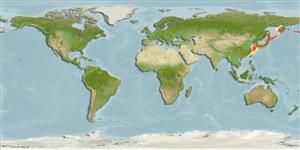Environment: milieu / climate zone / ระดับความลึก / distribution range
นิเวศวิทยา
เกี่ยวกับทะเล,น้ำเค็ม สัตว์น้ำหน้าดิน; สัตว์น้ำที่อาศัยและอพยพภายในทะเลเท่านั้น; ระดับความลึก 8 - 432 m (Ref. 50550). Polar; 3°C - 12°C (Ref. 6373)
Northwest Pacific: Japan Sea, south to Kasumi, Japan and Wonsan, Korea; Pacific coast of Hokkaido; Sea of Okhotsk; Avatcha Bay of eastern Kamchatka.
Length at first maturity / ขนาด / น้ำหนัก / Age
วัยเจริญพันธุ์: Lm 23.0, range 22 - 24 cm
Max length : 29.0 cm TL เพศผู้/กระเทย; (Ref. 56527); น้ำหนักสูงสุดที่มีการรายงาน: 192.00 g (Ref. 6373); อายุสูงสุดที่ได้รายงาน: 6 ปี (Ref. 56527)
Occurs primarily along the shelf and makes considerable seasonal migrations to its boundary and upper zone of the continental slope where they overwinter (Ref. 6373).
Life cycle and mating behavior
วัยเจริญพันธุ์ | การสืบพันธุ์ | การวางไข่ | เซลสืบพันธ์ของเพศเมีย(ไข่) | ความดกของไข่ | ตัวอ่อน
Sokolovskaya, T.G., A.S. Sokolovskii and E.I. Sobolevskii, 1998. A list of fishes of Peter the Great Bay (the Sea of Japan). J. Ichthyol. 38(1):1-11. (Ref. 27683)
IUCN Red List Status (Ref. 130435: Version 2024-2)
Threat to humans
Harmless
Human uses
การประมง: bycatch
เครื่องมือ
Special reports
Download XML
แหล่งที่มาจากอินเตอร์เน็ต
Estimates based on models
Preferred temperature (อ้างอิง
123201): 0.7 - 17.9, mean 8.6 °C (based on 235 cells).
Phylogenetic diversity index (อ้างอิง
82804): PD
50 = 0.5312 [Uniqueness, from 0.5 = low to 2.0 = high].
Bayesian length-weight: a=0.00389 (0.00180 - 0.00842), b=3.12 (2.94 - 3.30), in cm total length, based on all LWR estimates for this body shape (Ref.
93245).
ระดับชั้นอาหาร (อ้างอิง
69278): 3.3 ±0.1 se; based on diet studies.
ความสามารถในการกลับคืนสู่ปกติ (อ้างอิง
120179): ขนาดกลาง, เวลาต่ำสุดที่จะทำให้ประชากรเพิ่มขึ้นเป็น 2 เท่าใช้เวลา 1.4 - 4.4 ปี (Preliminary K or Fecundity.).
Fishing Vulnerability (Ref.
59153): Low vulnerability (19 of 100).
🛈
